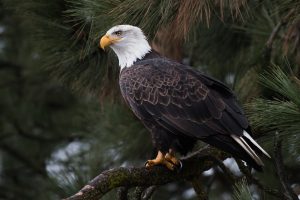Oklahoma Bar Journal
Wildlife and the Law: A 'Bird's-Eye View' of Various Laws Governing the Interactions Between People and Nature
By Rhonda J. McLean

Cliff | #185411586 | stock.adobe.com
Most of us go through our day-to-day lives without a second thought to the laws impacting the wildlife around us. Whether we find an injured animal on the road, take an annual hunting trip or fish at the local pond, various state and federal laws come into play. This article is not, in any way, a comprehensive guide to all those laws. It is merely a vehicle to help the reader consider which items they may not know that they do not know. “Nothing is more priceless and more worthy of preservation than the rich array of animal life with which our county has been blessed.”[1]
ENDANGERED SPECIES ACT
No article about wildlife would be complete without a discussion about endangered species. The Endangered Species Act[2] just celebrated its 50th anniversary. The act was established for the conservation of fish, wildlife and plants listed as threatened or endangered.[3] As of Dec. 25, 2023, the U.S. Fish & Wildlife Service Environmental Conservation Online System (ECOS) listed 1,482 animals as endangered or threatened in the United States.[4] Of those, the system reflected 22 species or populations believed to or known to occur in Oklahoma, made up as follows:
- four birds (two endangered, two threatened)
- six clams (four endangered, two threatened)
- five fish (one endangered, four threatened)
- one flowering plant (endangered)
- one insect (threatened)
- four mammals (endangered)
- one reptile (threatened)[5]
The Endangered Species Act provides for both civil and criminal penalties. Civil penalties can be assessed at up to $500, $12,000 or $25,000 per violation, depending on the violation.[6] Criminal violations incur fines of not more than $25,000, imprisonment of not more than six months or both.[7] Rewards shall be paid “to any person who furnishes information which leads to an arrest, a criminal conviction, civil penalty assessment, or forfeiture of property for any violation of this chapter or any regulation issued hereunder.”[8] Private citizen suits are also allowed as a means of enforcement under certain circumstances.[9]
BALD AND GOLDEN EAGLE PROTECTION ACT
The Bald and Golden Eagle Protection Act[10] was enacted June 8, 1940. The act prohibits the unlawful taking, possessing, selling, purchasing, bartering; offering to sell, purchase or barter; transporting, exporting or importing any bald eagle or golden eagle – alive or dead – or any part, nest or egg thereof.[11] Notably, this includes the possession of an eagle feather. The secretary of the interior may make exceptions for scientific, exhibition and religious purposes.[12]
The act provides for a first-offence fine of $5,000 and/or imprisonment of not more than one year, a second or subsequent offense fine of $10,000 and/or imprisonment of not more than two years, and each taking or act with respect to an eagle is a separate violation.[13] Further, one-half of any fine collected “shall be paid to the person or persons giving information which leads to conviction.”[14] Civil penalties may also be issued.[15]
MIGRATORY BIRD TREATY ACT
The Migratory Bird Treaty Act[16] protects migratory birds – any part, nest or egg of such birds and any product that consists or is composed, in whole or in part, of any such bird – or any part, nest or egg of such bird.[17] The act enables the secretary of the interior to determine when, to what extent (if at all) and by what means to allow the taking of such protected birds, pursuant to certain legislative guidelines.[18] The act does provide a specific exception for food supply breeding.[19] Violations of the act can result in either misdemeanor convictions with fines of not more than $15,000 and/or not more than six months imprisonment, felony convictions with fines of not more than $2,000 and/or imprisonment of not more than two years or fines under Title 18 of the United States Code and/or imprisonment of one year.[20]
HUNTING AND FISHING
Most readers are aware that hunting and fishing are regulated by the Oklahoma Department of Wildlife Conservation, and licenses are required to hunt and fish in Oklahoma. The Oklahoma Department of Wildlife Conservation website, www.wildlifedepartment.com, is a great resource. It has licensing information, regulations, approved locations, hunting season dates and more.
The Oklahoma Wildlife Conservation Code is contained in Title 29 of the Oklahoma Statutes.[21] Interestingly, the only other current statute contained in Title 29 deals with mechanical fishing devices and, more particularly, what type may be used and how, as well as what types are “illegal” and may be “confiscated as contraband.”[22]
There are specific statutory provisions for trespassing when hunting and fishing. Title 29 Ok. Stat. §5-202 provides for a misdemeanor conviction and a $500 to $1,500 fine and/or 30-day imprisonment for a first offense. For a second offense, it becomes a $1,500 to $2,500 fine and/or imprisonment of less than six months. Further, trespass can occur if a hunting dog is sent onto land to hunt, and the hunter goes onto the land to retrieve the dog.[23] Separate penalties apply if the trespassed land is an Oklahoma Farmed Cervidae Act licensed facility or a commercial hunting area licensed under 29 Ok. Stat. §4-106.[24]
Certain aspects of hunting are regulated by federal law and the U.S. Fish and Wildlife Service. Some of these include firearms on National Wildlife Refuge System lands,[25] the Endangered Species Act,[26] the Bald and Golden Eagle Act[27] and the Migratory Bird Treaty Act of 1918.[28]
Finally, if you are hunting in a tribal area, such as the Chickasaw National Recreation Area, be sure to check any additional regulations the tribe may have.
TAXIDERMY
If you hunt and fish, you may want to keep a part of your bounty. Taking your kill to a taxidermist for “stuffing” or “mounting” is a common way of memorializing your success. However, once you receive your trophy, it is yours to keep. Generally, wildlife may not be bought, sold, bartered or traded.[29] Dead wildlife, and the parts thereof, is included in the statutory definition of wildlife.[30]
There are exceptions to the prohibition on sale. For one, some exceptions exist for furbearing animals.[31] Additionally, under state law and under certain circumstances, a taxidermist may sell an unclaimed specimen.[32] Finally, native wildlife may be sold at an estate sale if the statutory requirements are met.[33]
As for taxidermists, they may also be bound by additional federal regulations. A federal permit is required to provide taxidermy services on migratory birds, their parts, nests or eggs.[34] Also, under the federal permit, the taxidermist must keep records of each transaction, including the parties involved, the number and species involved and certain completed forms.[35]

Author Rhonda McLean and her cat, Bridgette
WILDLIFE REHABILITATION
Wildlife rehabilitation facilities, such as WildCare Oklahoma and the Citizen Potawatomi Nation Eagle Aviary, are not zoos and are subject to different laws and regulations. A rehabilitation license does not permit a rehabber to keep wildlife as a pet. The facility must have a valid license from the Oklahoma Department of Wildlife, and if they plan to rehabilitate certain species of birds, they need a permit from the U.S. Fish and Wildlife Service Migratory Bird Office.
Under the annual Oklahoma license, rehabbers agree to be bound by 29 O.S. §5-601, Wildlife Breeders’ Sale and Transportation of Wildlife, “except for those parts referring to the sale of wildlife ... which is not authorized under this license.”[36] As part of the Oklahoma licensing process, the rehabber agrees that their information will be placed on a list that may be distributed to the public.[37] Additionally, anyone holding an Oklahoma wildlife rehabilitation license cannot also possess a commercial breeder’s license.[38] Further guidance for rehabilitation facilities can be found in Section 800:25 of the Oklahoma Administrative Code.[39]
Under federal law, the permit is in effect for up to five years. The applicant is bound by the Federal Migratory Bird Treaty Act and is directed to review 50 CFR §§10, 13 and 21.31. At a minimum, the applicant must be at least 18 years of age with at least 100 hours of hands-on experience gained over the course of at least one whole year “rehabilitating each type of migratory bird [they] intend to rehabilitate.”[40] There are many additional requirements: for example, minimum caging requirements, when euthanasia is required, length of captivity and the reporting of suspected criminal activity.[41]
CONCLUSION
Whether you are hunting, taking your kids out to fish, walking through your local park or neighborhood or dealing with an errant squirrel that has found its way into your garage, wildlife is all around us. Take a moment to remember all the diverse ways we impact their lives and all the different laws, regulations and agencies that can come into play. And then enjoy all that nature has to offer.
 ABOUT THE AUTHOR
ABOUT THE AUTHOR
Rhonda J. McLean is an attorney at Munson & McMillin PC in Edmond. She practices in the areas of real property litigation and title curative (both surface and oil and gas), probate and estate planning. She currently serves on the board of the Animal Law Section, as secretary of the Title Examination Standards Committee and as chairperson of the Real Property Law Section of the OBA. She recently joined the board of WildCare Oklahoma after serving as a volunteer for more than six years. She has previously served as editor of the Title Examination Standards Handbook and as president of the Oklahoma City Real Property Lawyers Association.
ENDNOTES
[1] Richard Nixon on the enactment of the Endangered Species Act. Dianah Voyles Pulver, “50 years ago, Democrats and Republicans agreed to protect endangered species,” USA Today, Dec. 28, 2023, p. 1.
[2] 16 U.S.C. §§1531 - 1544.
[3] 16 U.S.C. §1531.
[4] https://bit.ly/3OAgnCz.
[5] https://bit.ly/3wf9HDq.
[6] 16 U.S.C. §1540(a).
[7] 16 U.S.C. §1540(b).
[8] 16 U.S.C. §1540(d).
[9] 16 U.S.C. §1540(g).
[10] 16 U.S.C. §§668-668d.
[11] 16 U.S.C. §668(a).
[12] 16 U.S.C. §668a.
[13] 16 U.S.C. §668(a).
[14] Id.
[15] 16 U.S.C. §668(b).
[16] 16 U.S.C. §§703 - 712.
[17] 16 U.S.C. §703.
[18] 16 U.S.C. §704.
[19] 16 U.S.C. §711.
[20] 16 U.S.C. §707.
[21] 29 Ok. Stat. §1-101 - §10-105.
[22] 29 Ok. Stat. §1001.
[23] 1995 OK AG 37.
[24] 29 Ok. Stat. §7-209.
[25] 50 CFR §§27.41 and 27.42.
[26] 16 U.S.C. §§1531 - 1544.
[27] 16 U.S.C. §§668-668d.
[28] 16 U.S.C. 703-712.
[29] 29 Ok. Stat. §7-503.
[30] 29 Ok. Stat. §2-101.1.
[31] 29 Ok. Stat. §7-503(A).
[32] 29 Ok. Stat. §5-411.1.
[33] 29 Ok. Stat. §5-411.2.
[34] 50 CFR §21.24.
[35] 50 CFR §21.24(d)(1).
[36] Oklahoma Department of Wildlife Conservation Application for Wildlife Rehabilitation License.
[37] Id.
[38] Some exceptions will be made for a noncommercial breeder’s license.
[39] OAC §§800:25-38-1 - 800:25-38-12.
[40] “Frequently Asked Questions About a Federal Migratory Bird Rehabilitation Permit,” https://bit.ly/49sPJ6O.
[41] Id.
Originally published in the Oklahoma Bar Journal – OBJ 95 No. 3 (March 2024)
Statements or opinions expressed in the Oklahoma Bar Journal are those of the authors and do not necessarily reflect those of the Oklahoma Bar Association, its officers, Board of Governors, Board of Editors or staff.
